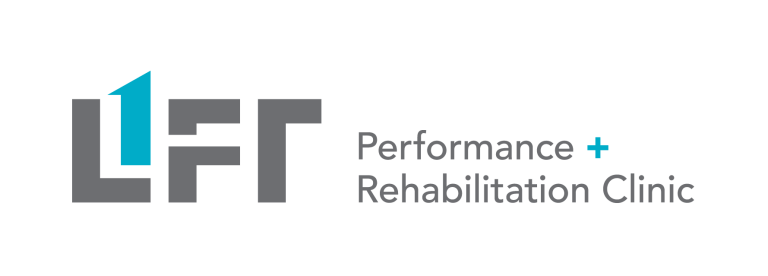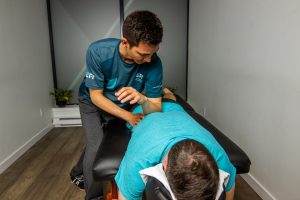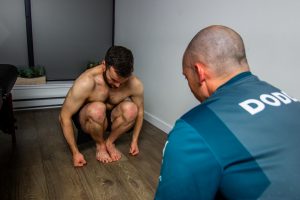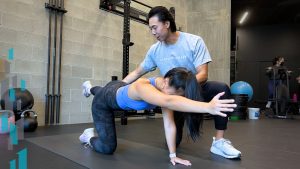Sitting is not the new smoking. It’s time we stop shaming ourselves for sitting and start doing something to turn sitting to a positive in our search for recovery, longevity, and performance.
Travis Dodds, Physiotherapist at Lift Clinic Vancouver Tweet
Physiotherapy Tips to Make Sitting as Physically Advantageous as Possible
The COVID-19 pandemic has led to a lot of people working from home and we've been getting a lot of people asking about how to sit properly when working from home.
In 2020 many of us have gone from the office job to the home-office job. But it seems our crummy posture has followed us. Worse, at home we may not have the right set-up and need to be more versatile in our workstations.
At Lift Clinic we’ve been seeing an increase in people with neck tension and headaches, as well as posture related back and hip pains.
It’s time we do something about this!
For years we’ve felt that standard postural advice and the status of most click-baity internet articles on sitting posture are really pretty light and lacking in useful information. And the HR presentation on sitting posture and workstation ergonomics has gotten very stale.
You know what I’m talking about – sit with your hips and knees at 90 degrees, with a tall straight alignment and shoulders down and back…. Blah blah blah.
It’s 2020 people, we can do better!
So today we’re going to update you on a more modern and versatile approach to sitting posture. And we’d also like to point out that if you have poor posture, or issues with neck or back pain and tension – there are likely underlying limitations in mobility, strength and body awareness that need to be addressed! Pain and tension are simply signals – your body asking for help. Helping people get over their limitations is what we do here at Lift Clinic on a daily basis.
With that said, if your goal is to optimize physical wellness, and you happen to have an office job, or you’re a student… well, you probably will continue to sit a lot!
We propose that you find ways to make the most of your time sitting.
For your personalized posture assessment and treatment plan, book in with physio at Lift Clinic.
How to correct your sitting posture whether you're working on a coffee table or at a souped-up workstation.
Sitting posture may be more important now than ever before. People will continue to use sitting as one of the many positions we get into throughout our day. We’re supposed to sit! But sitting for extended periods, while under a lot of mental stress is not likely to be great for us. Particularly if we don’t have good awareness of what proper sitting should look and feel like.
1. Stand up, then squat down to sit., just like squatting in the gym.

How do you initiate good sitting posture?
Key points:
- try slowly moving into your chair from standing, just as though you’re doing a careful squat exercise with perfect form
- if you’ve been taught by a knowledgeable strength coach, physiotherapist, chiropractor or massage therapist about how to squat properly, and what a good foot contact on the floor should feel like, where to position your legs to optimize position for your hip, knee and ankle joints etc… these skills will transfer perfectly!posture
2. Practice mindful contact with your seat!

Meaning, learn to feel an even contact with both cheeks (or sit-bones), shown in the picture above).
Consider this: the sensory input to the hand via a broad, whole-hand contact helps the body activate the right muscles for your push-up and Down-Dog! Whatever is in contact with the external environment should have a strong, coordinated and mindful contact.
Key points:
- ideally, you can feel a symmetrical contact – even on both sides.
- firmer seats are generally better so you can feel the surface below you.
3. Let your feet do their share.

In the best sitting posture, you will feel 10-50% of your body-weight supported through your feet, (depending on the angle of your trunk – see tip 4).
Key points:
- keep your feet flat on the floor with a “tripod” contact – weight distributed between the ball of foot, base of the pinky and the heel.
- fan your toes, and lay them gently on the floor.
- position the knee above the foot (over the middle toe or pinky toe).
4. Adjust trunk angle from the hip.

Sitting with 90-degree angles at the hip and knee, with a big bend in the neck is a no-no.
Key points:
- once you’ve reached the chair with your textbook squat form, adjust your trunk-angle by pivoting around the hip.
- this allows you to keep a straight, tall spine from top of head to tailbone, while directing your line of sight to the appropriate place.
- lean forward more (and put more weight on your feet) if you need to be looking at a laptop, paper on your desk or a coffee-table; for this you most likely want to be sitting at the front edge of your chair.
5. Square the ribs to the pelvis for better trunk mechanics and breath.

This is critical of almost all functional positions. We train this in the gym, in squats, planks, pushups, deadlifts. We train it in running form, in yoga, and in rehabilitation for back, shoulder and neck injuries. Keeping the ribs square to the pelvis enables an optimal breathing pattern with 360-degree expansion of the chest and diaphragm.
Key points:
- place your hands on your lower ribs.
- bend the trunk forward and backward to find your end-range of motion.
- zero in on a mid-range position that allows you to sit tall (neither slouching, nor arching the back).
6. Breathe deeply to assess your sitting posture.

Here’s another lesson you can apply to assess quality of most functional positions.
Key points:
- your deepest breath indicates your best posture.
- use full exhales and full inhales to help self-assess small adjustments to your posture; a better position generally gets you a fuller, more comfortable breath with a sense of evenly distributed effort and expansion.
- breath should expand in 360-degrees, forward, back, up, down and laterally (like a balloon inflating).
7. Check (and chuck) your crappy pants!

People are often very critical of their sitting posture. But what if it’s not all your fault? That’s right… your tight, restrictive pants, skirts, and shorts might be forcing your body into a poor posture – for HOURS! This really is not ok.
Key points:
- stand up, pull one knee up to your chest. Can’t? that’s a pants fail.
- with feet shoulder width apart, squat deeply towards the floor so that your hips get lower than your knees – are your pants stopping you? (note you can hold on to something in front of you if needed, to complete this test; note 2, if you can’t squat this deep, this also likely affects your sitting posture, and we can likely help you).
8. Plan sitting posture resets. Consistency pays off.

You might find yourself slipping into a poor sitting posture every 10 minutes. That’s normal – in fact, the body needs movement as often as every 15 minutes to help bloodflow, circulation and long term health of muscles and joints. What you need is an easy way to RESET back to a good position!
Key points:
- re-establish your good posture frequently.
- 5 to 10 deep breaths will help activate your “muscle memory” and keep you in a good posture a little longer.
- longer movement breaks such as a 10 minute brisk walk or 10 minute yoga, chair yoga, or even 3 really good stretches will provide a more lasting reset and stimulate your body and mind.
9. Develop your hip mobility.

Normal hip mobility includes 120 degrees of hip flexion, 40 degrees of internal rotation and 40 degrees of external rotation.
Key points:
- if your hips are tight, it’ll make it hard to access optimal sitting posure.
- tight hips will encourage you to find a position that takes pressure off them.
- some people have tight hips due to bony anatomy.
- other people have tight hips due to trunk mobility limitations (tight back).
- others simply have tight muscles and need to learn specific, effective and convenient stretches to overcome this.
- this is best to assess and treat clinically so you can understand the root cause of your mobility limitations and address them efficiently.
10. Develop your trunk mobility.

The most common defecits we see clinically are limited thoracic extension and limited lumbar flexion.
Key points:
- the trunk and spine are capable of forward, backward, sideways and rotational movements.
- clinically, we COMMONLY see range of motion limitations of about 50% in the trunk.
- if you could only move your elbow 50% range of motion, you couldn’t feed yourself and you’d be panicking; yet somehow we can “ignore” this massive mobility defecit in the trunk!
- the body tries to tell you something is wrong, usually in the form of neck, shoulder or low back tension and pain.
- this is something that benefits massively from in-person clinical assessment and treatment.
11. Allow yourself some variability.

It’s not normal, or good for you, to slouch 90-100% of your 8-hour work or school day. But we also don’t expect you to sit rigidly tall for 8 hours.
Key points:
- if your hips are tight, it’ll make it hard to access optimal sitting posure.
- tight hips will encourage you to find a position that takes pressure off them.
- some people have tight hips due to bony anatomy
- other people have tight hips due to trunk mobility limitations (tight back).
- others simply have tight muscles and need to learn specific, effective and convenient stretches to overcome this.
- this is best to assess and treat clinically so you can understand the root cause of your mobility limitations and address them efficiently.
12. Good sitting posture takes time.

Reading this article is not likely to fix your posture. So what will?
Key points:
- make an ongoing commitment to improving your posture.
- seek and find personalized, detailed information about your body – in our world we gain this information through assessment.
- exercise will help too, often in 3 forms:
- daily movement discipline, such as a 10-minute yoga and 10-minute purposeful stretch (this gives you a foundation to self-assess and practice good quality movement).
- 150-300 minutes per week of moderate intensity exercise (this will mobilize your trunk and ribs, and strengthen your diaphragm, among many other health benefits).
- 2-3 days a week strength training (this will offset muscle loss from a sedetary lifestyle and train proper movement patterns, like the squat for example!)
Watch: Sitting is the New Squatting with Vancouver Physiotherapist Travis Dodds
What the best internet posture articles in the world aren't telling you - a word from the Author
We really hope this information will be helpful to you. We use this article and information to educate our clients and have chosen to share it freely on the internet because we value freedom of information and helping people from all walks of life, where ever they are in the world.
In reality, I’ve worked really hard on my posture and had multiple experiences where, in spite of my own knowledge of my body, I’ve been helped by professionals around me. Physios, massage therapists, chiropractors, strength coaches. Learning about my body, the root causes of limitations to movement, and (when possible) overcoming these limitations has been an amazing journey.
What a good therapist can do to assess you visually – measuring and observing for movement quality, and quantity; as well as assessing manually with skilled hands… this is invaluable. Being part of a process with a dedicated professional who understands your motivation and desire to improve is priceless. We’re grateful for the opportunity to do this with our clients every day.








